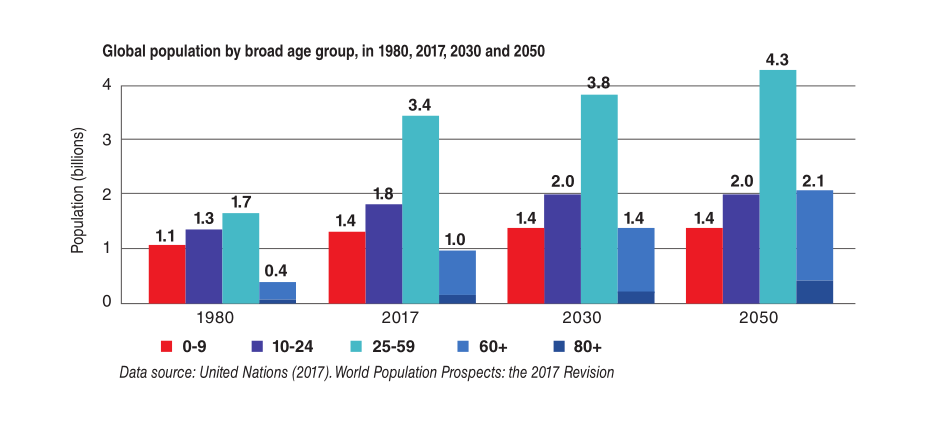Aging population a global challenge


People aged 60 and above will outnumber 10- to 24-year-olds in 2050, UN says
The world population is aging fast.
According to the most recent population report from the United Nations, the global population aged 60 and over numbered 962 million in 2017, more than double the number of 382 million in 1980. It will take fewer years to double the number again. The report projects that by 2050, the population aged 60 and above will reach 2.1 billion.
Globally, the population aged 80 years or over is projected to increase more than threefold between 2017 and 2050, rising from 137 million to 425 million.
The population's aging trend is inevitable due to declining fertility rates and improved survival rates. The UN projections indicate that there will be more persons aged 60 or over than adolescents and youth aged 10 to 24 in 2050-2.1 billion versus 2 billion.
The demographic shift is occurring throughout the world. The UN report shows that each of the 201 countries or areas with at least 90,000 inhabitants in 2017 is projected to see an increase in the proportion of persons aged 60 or over between 2017 and 2050.
Overall, population age is determined by average longevity, birthrate and immigration. The aging situation differs from country to country and region to region.
Europe will be the oldest of all-in 2050, people aged 60 and over are expected to account for 35 percent in Europe, 28 percent in North America, 25 percent in Latin America and the Caribbean, 24 percent in Asia, 23 percent in Oceania and 9 percent in Africa.
"Aging is a global issue, especially in developed worlds, it will have a profound demographic shock on political and economic systems in the years ahead," said Jon Taylor, political science professor at University of St. Thomas in Houston.
When it comes to individual countries, Japan is ranked the oldest of all.
In 2018, about 28 percent of Japan's population was 65 and over, according to data provided by Population Reference Bureau. The number of people aged 70 or older reached 20 percent.
The bureau projects that by 2050, 36 percent of Japan's population will be 65 or older. Coupled with a low birthrate of 1.4 in 2018, Japan faces serious labor shortage issues.
The United States is also aging. A recent report by the US Census Bureau indicates that by 2030, all baby boomers will be older than 65. The number of people over 65 is projected to reach 78 million, surpassing the projected number of 76.7 million children under 18 for the first time in 2030.
The most populous country, China, is now younger than the US with 11 percent of the population aged 65 and older in 2018. However, China is projected to be "older" than the US with projected old population percentage at 26 percent by 2050.
"China is very wise to encourage people to have more children because that will help the dependent ratio," said Marcia Ory, professor and founding director of Texas A&M Center for Population Health and Aging.
China ended its decades-old one-child policy at the end of 2015, allowing all married couples to have two children. However, new births in China nonetheless fell to 15.23 million last year, compared to 17.86 million in 2016 and 17.23 million in 2017.































